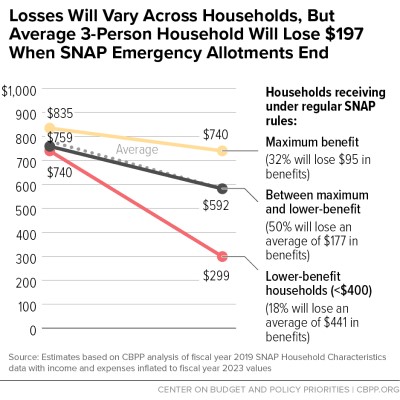Anti-hunger advocates say rising food costs combined with the expiration of an emergency increase in Supplemental Nutrition Assistance Program benefits could erase some gains in food security realized during the pandemic.
Food insecurity dropped during 2020 and through 2021. Eric Mitchell, executive director of the Alliance to End Hunger, a coalition of more than 100 organizations committed to reducing food insecurity, said lawmakers came together at the start of the pandemic to put the emergency SNAP allotments in place because they recognized the pandemic could exacerbate food insecurity.
Mitchell said ethnicities normally disproportionately impacted by hunger and food insecurity saw improvements. According to USDA, the share of Black households facing food insecurity fell by 8%; food insecurity among Hispanic households fell by 3%.
“With these allotments going away, that’s where you’re going to see those gaps start once again, increasing and getting wider and wider,” Mitchell said.
For families in 18 states, the emergency allotments already ended. Those states include Alaska, Arizona, Arkansas, Florida, Georgia, Idaho, Indiana, Iowa, Kentucky, Mississippi, Missouri, Montana, Nebraska, North Dakota, South Carolina, South Dakota, Tennessee and Wyoming. For the remaining 32 states, plus the District of Columbia, Guam and the U.S. Virgin Islands, the extra funding will disappear with the March benefit.
 Mitchell told Agri-Pulse he believes the end of emergency allotments, which provided an average of $82 per person and at least $95 per household, helped close the gap that exists for many SNAP-dependent families who find the benefits typically only get them through three weeks of every month.
Mitchell told Agri-Pulse he believes the end of emergency allotments, which provided an average of $82 per person and at least $95 per household, helped close the gap that exists for many SNAP-dependent families who find the benefits typically only get them through three weeks of every month.
In recent months the allotments have provided about $3 billion each month in additional SNAP benefits in the states in which they are in effect, according to the Center on Budget and Policy Priorities.
CBPP also noted that the emergency allotments “kept 4.2 million people above the poverty line in the last quarter of 2021, reducing poverty by 10% ― and child poverty by 14% ― in states with EAs at the time.”
The Food Research and Action Center said the steepest cliff will be for older adults at the minimum benefit level who will have their monthly SNAP benefits fall from $281 to $23. In addition, on May 11, the COVID-19 federal public health emergency will end, imposing work requirements on able-bodied adults without dependents.
The combination of an increased government action and charitable food systems showed that the unprecedented federal response can make an impact on improving food insecurity, said Emily Engelhard, vice president of research and translation at Feeding America.
“It's very clear that this support prevented us from going into what could have been a real crisis around food security. It is really interesting evidence that shows that we actually do have the capability to address food insecurity in our country,” she said.
Mitchell praised states such as Massachusetts and New Jersey that are trying to make up for the loss of the federal benefit increase. New Jersey will be implementing legislation that sets a $95 minimum benefit for New Jersey SNAP households. Massachusetts is allocating $130 million for three months of partial extra SNAP benefits.
According to estimates from Feeding America, SNAP provides nine times the number of meals the food bank network does. Englehard stated that during the height of the pandemic, 60 million people were visiting charitable food programs. In 2021, it dropped to 53 million, but that’s still substantially higher than the 40 million people in 2019. Meanwhile, food costs are up more than 10% compared to a year ago, creating a need for additional investment from food banks that need to purchase food and requiring greater fundraising revenue or the use of their reserve funds.
ParentsTogether surveyed more than 550 primarily low- and middle-income parents which found that 52% of respondents said they've used food banks or similar services to deal with the higher food costs.
The survey also asked about their state of financial insecurity amid rising prices in the U.S. and an end to the pandemic’s nutrition benefits. The survey, taken between Feb. 1-9, 2023, found 64% of respondents said their family is finding it hard to make ends meet right now, with an identical amount saying one of their biggest challenges is affording food. The survey also noted 40% of respondents answered they could no longer afford enough food for their family, and 36% have skipped meals so their kids can eat.
Don’t miss a beat! It’s easy to sign up for a FREE month of Agri-Pulse news! For the latest on what’s happening in Washington, D.C. and around the country in agriculture, just click here.
Ailen Arreaza, executive director of ParentsTogether, said lawmakers shouldn't be talking about cutting SNAP further at a moment when food distribution centers are seeing increases in demand as American families struggle to feed their children.
To Mitchell, the pandemic assistance showed federal resources could have an impact on food insecurity.
“As Congress starts to tee up for the next farm bill, we're using this as kind of the springboard to ensure that they don't push for policies that will make this gap even wider,” Mitchell said.
 Eric Mitchell, Alliance to End Hunger
Eric Mitchell, Alliance to End HungerThe Alliance to End Hunger will be formalizing more of its farm bill priorities in the next week, Mitchell said. The main focus will be on eliminating barriers to access, including restrictions on SNAP benefits for those convicted of drug-related felonies. The alliance also wants to allow the use of SNAP benefits for prepared meals and online food purchases.
He said the success of reducing food insecurity, especially in certain populations, provides a great narrative for those wanting to educate members of Congress on the importance of continued federal support.
“Now is not the time for us to start to take backward steps and roll [SNAP] back, particularly as we’re still seeing the impact of the pandemic as it relates to higher food costs,” Mitchell said. “It would be our hope that elected officials have the courage to be innovative and look at ways to actually make these programs reach further to the people that really do need them.”
For more news, visit www.Agri-Pulse.com.


